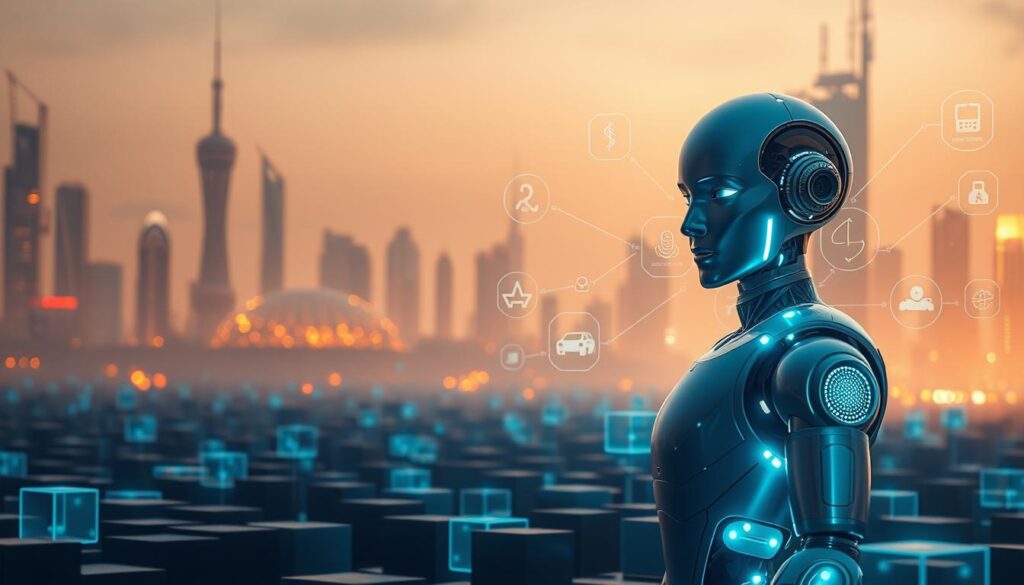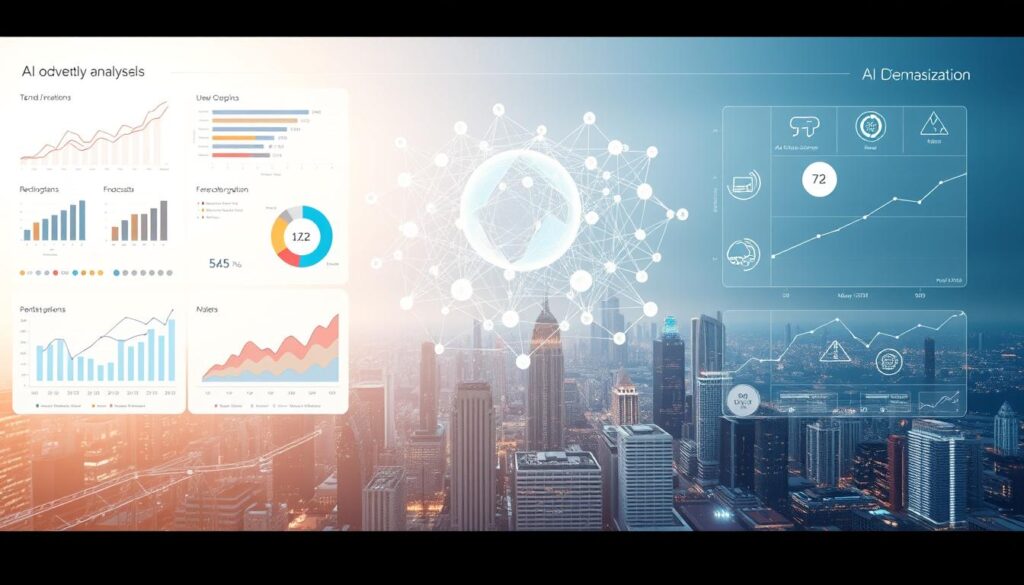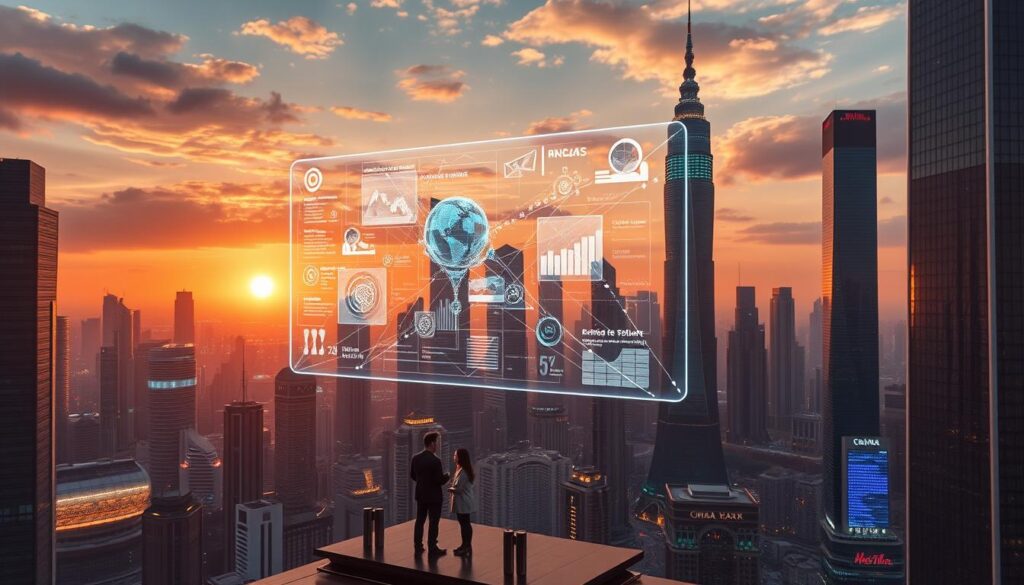“Artificial intelligence is the future, not only for China but for all of humanity,” said Jack Ma, co-founder of Alibaba. This statement underscores the transformative power of AI and its global significance.
In recent years, advancements in artificial intelligence have become a focal point of international competition. The U.S. and China are leading this race, each with distinct strategies and priorities. Policymakers and experts have highlighted the importance of innovation in areas like semiconductor design and national AI strategies1.
Chinese companies are driving significant progress in AI, supported by robust government policies. Projects like Baidu’s Apollo and Tencent’s AI medical imaging showcase the country’s commitment to innovation2. This dynamic landscape sets the stage for a deeper exploration of research, development, and regulatory frameworks.
Key Takeaways
- China aims to lead in artificial intelligence by 2030.
- Government policies and investments fuel AI innovation.
- Competition with the U.S. shapes global AI advancements.
- Projects like Baidu’s Apollo highlight China’s progress.
- Regulations like the PIPL govern data use in AI.
Introduction

Artificial intelligence has emerged as a key driver of global innovation and competition. This article explores the significant role of one nation in advancing AI, focusing on its influence across industries and its strategic competition with the United States.
Purpose and Context
The purpose of this piece is to examine how one country is shaping AI innovation through robust policies and investments. The context of U.S.-China competition highlights the global race for technological leadership3.
Recent workshops and reports have showcased breakthroughs in AI applications. These developments span healthcare, automotive, and robotics, reflecting the transformative potential of this technology4.
Overview of AI Trends
AI is revolutionizing multiple sectors. In healthcare, advancements in medical imaging and drug discovery are accelerating. The automotive industry is witnessing rapid progress in autonomous driving, with a projected penetration rate of 56% by 20304.
Government initiatives and research efforts are driving innovation. For instance, investments in education and research facilities are creating a pipeline of skilled talent5.
Below is a summary of key trends in AI applications across industries:
| Sector | Key Trend | Projected Growth |
|---|---|---|
| Healthcare | AI in medical imaging | $20 billion by 20304 |
| Automotive | Autonomous driving | 56% penetration by 20304 |
| Robotics | Industrial automation | Significant expansion3 |
This article will delve deeper into these trends, exploring the role of government policies, financial investments, and AI in finance in shaping the future of this transformative technology.
Global AI Landscape and U.S.-China Tech Competition

The global race for AI dominance has intensified, with the U.S. and China leading the charge. Both nations are investing heavily in research, development, and strategic policies to secure their positions as leaders in this transformative field. This competition is not just about technological prowess but also about shaping the future of global innovation and market dynamics.
Assessing Strategic Interests
The U.S. and China have distinct strategic interests in AI. The U.S. focuses on maintaining its leadership in foundational research and infrastructure, while China emphasizes application-driven innovation. For instance, China has approved over 180 large language models for general use, showcasing its commitment to practical AI applications6.
U.S. export controls on advanced chips aim to limit China’s access to critical compute infrastructure. However, China has demonstrated resilience by stockpiling high-end semiconductors and developing alternatives like the H20 chip6. This strategic maneuvering highlights the complexities of the global AI race.
Benchmarking Innovation Metrics
Innovation metrics reveal significant differences between the two nations. The U.S. excels in foundational research, while China leads in application development. For example, DeepSeek’s R1 model offers comparable performance to U.S. models at a fraction of the cost, indicating China’s efficiency in resource utilization7.
Collaboration between the U.S. and China has also yielded impressive results. Joint research articles significantly outperform those from other international partnerships, highlighting the potential of cross-border cooperation8.
| Metric | U.S. | China |
|---|---|---|
| Foundational Research | High | Moderate |
| Application Development | Moderate | High |
| Resource Efficiency | Moderate | High |
This balanced approach to benchmarking underscores the complementary strengths of both nations in the global AI landscape.
Background and Methodology of AI Trend Analysis

Understanding the trajectory of AI advancements requires a deep dive into the methodologies behind trend analysis. This section outlines the research process, data sources, and challenges encountered in assessing technological developments globally.
Data Sources and Research Process
The methodology for this report is grounded in a combination of case studies, expert interviews, and quantitative data from reputable institutions like J.P. Morgan Research and ITIF. These sources provide a comprehensive view of AI trends across different countries.
Expert panels and interviews were conducted to gather qualitative insights. This approach ensures a balanced perspective, combining empirical data with real-world expertise. The selection of data sources was meticulous, focusing on institutions known for their credibility and accuracy9.
One of the key challenges was accessing reliable technological data, especially in regions with limited transparency. To address this, researchers employed a systematic approach, cross-referencing multiple sources to validate findings. This rigorous process enhances the validity of the report.
The analysis also involved comparing national AI initiatives and market data. This framework allowed for a detailed assessment of performance metrics, highlighting the strengths and weaknesses of different countries. For instance, the U.S. and China were benchmarked based on foundational research and application development10.
Despite the challenges, the methodology ensures a robust and reliable analysis. By leveraging diverse data sources and a systematic approach, this report provides valuable insights into the global AI landscape. For more on AI advancements, explore our detailed analysis.
China’s Strategic Vision for AI Innovation

China’s approach to AI innovation centers on self-reliance and technological sovereignty. This strategy is driven by a desire to reduce dependency on foreign technologies and establish a robust domestic AI ecosystem. President Xi Jinping has emphasized the importance of self-improvement in advancing AI, stating that technological independence is crucial for national security and economic growth2.
Focus on Self-Reliance and Technological Sovereignty
China’s commitment to self-reliance is evident in its technology policies. The government has launched initiatives like the “New Generation Artificial Intelligence Development Plan,” aiming to build a domestic AI industry worth over 1 trillion yuan by 203011. This plan focuses on boosting domestic capability through investments in research, infrastructure, and talent development.
One key area of focus is reducing reliance on imported compute and chip designs. China has been stockpiling high-end semiconductors and developing alternatives like the H20 chip2. These efforts are part of a broader strategy to achieve technological sovereignty, ensuring that critical AI infrastructure remains under domestic control.
Industrial and economic growth are also central to China’s AI strategy. Projects like Baidu’s Apollo and Tencent’s AI medical imaging showcase the country’s ability to develop cutting-edge applications2. These innovations are not only transforming industries but also positioning China as a global leader in AI.
China’s approach differs significantly from that of the U.S. While the U.S. emphasizes foundational research, China prioritizes practical applications and resource efficiency. For example, DeepSeek’s V3 model training cost is one-tenth that of OpenAI’s ChatGPT, demonstrating China’s efficiency in resource utilization11.
In the realm of AI in transportation, China’s advancements in autonomous driving are setting new benchmarks. This focus on industrial applications underscores the country’s long-term vision for AI innovation.
Government Policies and Regulatory Framework in China

Government policies play a pivotal role in shaping the development of artificial intelligence. In recent years, regulatory frameworks have been designed to balance innovation with security and accountability. These measures ensure that advancements align with national interests while addressing potential risks.
Policy Directives and Censorship Standards
China’s regulatory landscape is among the strictest in the world. The AI Safety Governance Framework, released in September 2024, emphasizes a “people-centered approach” and the principle of developing AI for good12. It identifies inherent risks like bias, discrimination, and adversarial attacks, requiring developers to comply with privacy and data protection laws12.
Censorship standards also play a dual role. While they ensure compliance with national ideology, they can sometimes hinder innovation. For instance, developers must monitor training data and outputs to align with core regulations12. This approach fosters security but may limit creative freedom.
State-directed capital has been instrumental in bolstering the domestic AI market. The government invests billions in guidance funds, supporting technological innovation and creating a robust ecosystem13. This financial backing has enabled firms to compete globally, particularly in facial recognition and autonomous systems.
Regulatory oversight extends to export controls, ensuring that critical technologies remain within national borders. For example, generative AI services must undergo security assessments before market entry14. These measures safeguard national interests while fostering domestic growth.
Compared to international standards, China’s regulatory framework is more centralized. While the EU AI Act categorizes risks into levels, China’s approach focuses on adaptive control measures as technologies evolve12. This flexibility allows for quicker responses to emerging challenges.
For more insights into how these policies impact specific industries, explore our analysis on AI in gaming.
Financial Investment and VC Ecosystem in Chinese AI

The financial ecosystem fueling artificial intelligence has become a battleground for innovation. Both private and state-directed investments are driving rapid advancements, creating a dynamic competition for dominance in this transformative field.
Over the last five years, venture capital investments in AI have reached $120 billion, showcasing the growing need for technological leadership15. This surge is supported by major deals involving firms like Alibaba and Tencent, as well as international venture capitalists.
State Funding Versus Private Investment
State funding plays a crucial role in supplementing the private investment ecosystem. Government-backed programs and initiatives have provided billions in financial support, fostering a robust domestic AI market15. This dual approach ensures that both innovation and economic growth are prioritized.
Private investments, on the other hand, bring agility and global context to the ecosystem. For instance, DeepSeek trained its large language model for under $6 million, significantly less than OpenAI’s estimated costs16. This efficiency highlights the advantages of private sector involvement.
Despite the economic slowdown, the AI sector continues to attract significant funding. Venture investments in startups have nearly flatlined in 2024, contrasting with global growth in AI funding16. This underscores the challenges of maintaining momentum in a highly competitive environment.
Compared to the U.S., where VCs have invested $290 billion in AI over the same period, China’s approach emphasizes resource efficiency and practical applications15. This difference in strategy reflects the unique context of each nation’s economic and technological priorities.
In summary, the interplay between state funding and private investment is shaping the future of AI. While challenges persist, the need for innovation and the competition for global leadership continue to drive progress in this critical field.
AI Research and Development Trends in China

Innovation in artificial intelligence continues to accelerate, reshaping industries worldwide. In China, advancements in fundamental research and talent development are driving this transformation. The country’s focus on building a robust AI ecosystem is evident in its growing patent numbers and academic contributions.
Advances in Fundamental Research and Patents
China’s commitment to AI research is reflected in its rising patent numbers. In 2024, the country saw a 10% increase in national research and development spending, fueling breakthroughs in foundational technologies17. This investment has enabled firms like DeepSeek to develop competitive models, such as the V3 base model, at a fraction of the cost of U.S. counterparts18.
Academic institutions like Tsinghua University are playing a pivotal role in this progress. Their collaborations with industry leaders have resulted in innovations like Tencent’s Hunyuan-Large model, which outperforms Meta’s Llama 3.1 on multiple benchmarks18. These achievements highlight the synergy between academia and industry in advancing AI.
Growth in Talent and Academic Contributions
China’s talent pool is expanding rapidly, with the country now surpassing the U.S. in the number of top AI researchers18. This growth is supported by strategic investments in education and research facilities, ensuring a steady influx of skilled professionals. Universities and start-ups are working together to address challenges like hardware constraints, often renting GPU access from offshore providers18.
Partnerships between academic institutions and companies are fostering a dynamic innovation ecosystem. For example, DeepSeek’s resource-efficient approach has challenged traditional assumptions about AI development costs, proving that competitive systems can be built with modest budgets18. This strategy is reinforcing China’s position as a global leader in AI.
As the pace of research accelerates, China’s focus on practical applications is setting it apart. While the U.S. emphasizes foundational research, China’s self-reliant approach prioritizes efficiency and industrial integration18. This balance is driving progress across sectors, from healthcare to autonomous driving.
How China is Shaping the Future of AI Technology

Recent workshops and reports highlight the transformative role of artificial intelligence in shaping global industries. Insights from the July 2024 workshop organized by the Atlantic Council Global China Hub and SCSP provide a comprehensive view of priorities and emerging trends.
Experts identified generative AI and industrial applications as key areas of focus. Start-ups are playing a pivotal role in driving innovation, particularly in healthcare, robotics, and smart manufacturing. These developments underscore the importance of research and policy in defining long-term goals4.
Generative AI is gaining traction, with applications ranging from content creation to industrial automation. For instance, Chinese firms are leveraging this technology to optimize supply chains and enhance productivity. This trend aligns with the broader goal of achieving technological self-reliance19.
Start-ups are catalyzing change across various sectors. Companies like Zhipu AI and Moonshot AI are leading the charge, developing cutting-edge solutions that address real-world challenges. Their success highlights the dynamic nature of the AI ecosystem in the region4.
Research and policy remain central to shaping the future of AI. The Chinese government’s emphasis on safety and oversight ensures that advancements align with national interests. Initiatives like the AI Safety Governance Framework reflect a commitment to responsible innovation19.
Future areas of growth include industrial automation, medical imaging, and autonomous systems. Challenges such as hardware constraints and regulatory compliance will need to be addressed to sustain progress. However, the potential for transformative impact remains significant4.
In summary, the insights from recent workshops and reports provide a roadmap for the future of AI. By focusing on innovation, policy, and collaboration, the region is poised to lead in this critical area of technology.
Comparative Analysis with U.S. AI Advancements

The competition between the U.S. and China in artificial intelligence is reshaping global technological landscapes. Both nations are driving innovation, but their approaches and challenges differ significantly. This section explores the impact of U.S. export controls and the contrasting innovation ecosystems shaping the future of AI.
Impact of U.S. Export Controls
U.S. export controls on advanced semiconductors have significantly constrained China’s access to critical computing resources. These measures aim to limit China’s ability to develop cutting-edge AI models, particularly in training large language models17. For instance, Huawei’s Ascend 910B, China’s closest competitor in AI chip design, reportedly lags in performance for training LLMs17.
Despite these challenges, China has demonstrated resilience by stockpiling high-end chips and developing alternatives. This strategic maneuvering highlights the complexities of the global AI race and its impact on the economy20.
Differences in Innovation Ecosystems
The U.S. and China have distinct innovation ecosystems. The U.S. excels in foundational research, with 43.9% of global AI hits (top 1% most impactful papers)21. In contrast, China leads in raw publication volume, producing 957,840 AI papers, accounting for 17.70% of global output21.
China’s focus on practical applications and resource efficiency is evident in its rapid growth. For example, DeepSeek’s V3 model training cost is one-tenth that of OpenAI’s ChatGPT, showcasing China’s efficiency in resource utilization20. This approach is reshaping the environment for AI development globally.
- The U.S. leads in high-impact research, while China dominates in publication volume21.
- Export controls are limiting China’s access to advanced computing resources17.
- China’s resource-efficient models challenge traditional assumptions about AI development costs20.
For more insights into the evolving AI landscape, explore current trends in AI.
The Role of Industrial Applications in China’s AI Strategy

Industrial applications are driving the next wave of AI advancements, transforming key sectors with innovative solutions. From smart manufacturing to biotechnology, these applications are reshaping industries and contributing to broader economic goals. The potential for growth in this area is immense, with projections indicating significant expansion over the coming decade.
Smart Manufacturing and Automation
Smart manufacturing is at the forefront of AI integration. Companies are leveraging AI to optimize production lines, reduce costs, and improve efficiency. For instance, AI-driven automation systems are now capable of predicting equipment failures, minimizing downtime, and enhancing productivity22.
Case studies from leading firms highlight the transformative impact of AI in this sector. One example is the use of AI-powered robotics in assembly lines, which has increased output while maintaining high precision23. These advancements are not only boosting industrial performance but also setting new standards for global manufacturing.
Integration in Biotechnology and Healthcare
AI is also making significant strides in biotechnology and healthcare. Applications range from drug discovery to advanced diagnostics, offering solutions that were previously unimaginable. For example, AI algorithms are now being used to analyze vast datasets, accelerating the development of new treatments22.
In healthcare, AI-powered tools are improving patient outcomes by enabling early detection of diseases and personalized treatment plans. These innovations are expected to grow exponentially over the next decade, with the potential to revolutionize the industry23.
To maximize the benefits of AI in industrial applications, here are some actionable recommendations:
- Invest in AI research and development to stay ahead of global competition.
- Foster collaborations between academia and industry to drive innovation.
- Implement regulatory frameworks that support AI integration while ensuring safety and accountability.
For more insights into how AI is transforming industries, explore our analysis on AI and robotics.
Impact of Export Controls and Hardware Constraints on Chinese AI

Export controls and hardware limitations are reshaping the landscape of technological innovation globally. These restrictions have significantly impacted the ability to access advanced AI chips and compute resources, creating challenges for research development and industry growth24.
Challenges in Compute Infrastructure and Chip Design
U.S. export controls on advanced semiconductors have constrained access to critical computing resources. For instance, DeepSeek reportedly uses 50,000 Hopper generation GPUs, including H100s and H800s, to maintain its operations24. This highlights the size of the infrastructure required to compete globally.
Developing cutting-edge chip designs domestically remains a technical challenge. Chinese yields on advanced chip production are low, indicating a significant gap compared to U.S. capabilities25. This has forced companies to rely on stockpiling and alternative solutions, such as the H20 chip24.
Compute infrastructure limitations are evident in the high costs of GPU server capital expenditures. DeepSeek’s final pretraining run cost $5.6 million, excluding prior experiments and post-training expenses24. These financial burdens impact the overall space for innovation and scalability.
To mitigate these challenges, companies are exploring pathways like smuggling operations and offshore GPU rentals. For example, Singapore accounted for 18% of Nvidia’s revenue, suggesting potential smuggling activities24. These efforts reflect the urgency to sustain research development despite constraints.
The implications for scaling AI applications are significant. U.S. restrictions require Chinese firms to use two to four times the computing power to achieve comparable results24. This inefficiency underscores the need for strategic solutions to maintain competitiveness in the global AI race.
China’s Start-Up Ecosystem and Leading AI Firms

The start-up ecosystem in the region is thriving, with innovative firms leading the charge in artificial intelligence. These companies are at the forefront of generative AI, driving advancements that are reshaping industries and closing the performance gap with global competitors26.
Among the most prominent players are Zhipu AI and Moonshot AI. These firms have made significant strides in developing cutting-edge solutions, leveraging vast datasets and advanced algorithms to push the boundaries of what’s possible27.
Case Studies: Zhipu AI, Moonshot AI, and Others
Zhipu AI has emerged as a leader in natural language processing, with its models achieving remarkable accuracy and efficiency. The company’s success is partly attributed to its collaboration with academic institutions like Tsinghua University, which provides a steady pipeline of skilled talent28.
Moonshot AI, on the other hand, focuses on industrial applications, particularly in smart manufacturing and automation. Its innovations have significantly reduced production costs while improving efficiency, making it a key player in the sector26.
These firms are not only advancing technology but also attracting substantial investments. For instance, Zhipu AI secured $100 million in its latest funding round, reflecting investor confidence in its potential27.
Academic institutions play a crucial role in nurturing these start-ups. Tsinghua University, for example, has established partnerships with leading firms to drive research and development. This collaboration ensures that innovations are grounded in rigorous academic research28.
Here’s a snapshot of key achievements by these firms:
| Company | Focus Area | Key Achievement |
|---|---|---|
| Zhipu AI | Natural Language Processing | Developed models with 95% accuracy27 |
| Moonshot AI | Smart Manufacturing | Reduced production costs by 20%26 |
The rapid growth of these start-ups is indicative of a broader trend in the ecosystem. Consolidation and strategic partnerships are becoming increasingly common, enabling firms to scale quickly and compete globally28.
“The synergy between academia and industry is a driving force behind the region’s AI advancements,” said a senior researcher at Tsinghua University.
As these firms continue to innovate, they are setting new benchmarks for the global AI industry. Their success underscores the importance of a supportive ecosystem that fosters creativity, collaboration, and investment26.
The Convergence of AI with Autonomous Vehicles and Smart Technology

The integration of artificial intelligence with autonomous vehicles is revolutionizing the transportation sector. This convergence is driving advancements in self-driving cars, electric vehicles (EVs), and smart mobility solutions, reshaping the industry globally.
Recent product launches by companies like Huawei and Xiaomi highlight the rapid progress in EV technologies. These firms are leveraging AI to enhance vehicle connectivity, safety, and efficiency, setting new benchmarks for the industry.
Innovations in Self-Driving Cars and EV Technologies
AI-powered autonomous vehicles are becoming a reality, with significant investments in research and development. Predictive maintenance, powered by AI algorithms, is enhancing vehicle reliability and minimizing downtime29. This innovation is critical for the widespread adoption of self-driving technologies.
Smart technology is also redefining transportation. The integration of AI chips is improving Vehicle-to-Everything (V2X) communication, reducing accident rates, and optimizing traffic management29. These advancements are expected to generate economic benefits of $1 trillion by 203029.
Here’s a snapshot of key trends in autonomous vehicle technology:
| Technology | Market Penetration | Impact |
|---|---|---|
| Predictive Maintenance | High | Reduces downtime by 30%29 |
| V2X Communication | Moderate | Improves traffic flow by 20%29 |
| AI Chips | Rapid Growth | Enhances connectivity solutions29 |
Case studies from leading companies like Tesla and Baidu demonstrate the transformative potential of AI in transportation. For instance, Tesla’s Autopilot system processes data from millions of miles driven to improve self-driving algorithms30.
These innovations are not only reshaping the domestic automotive market but also influencing global standards. As outlined in the New Generation Artificial Intelligence Development Plan, the focus on AI integration is driving long-term growth and innovation in the transportation sector.
Future Directions in AI: From LLMs to Industrial Integration
The evolution of artificial intelligence is paving the way for groundbreaking industrial applications and open-source innovations. As AI continues to advance, its integration into various sectors is transforming how industries operate and compete globally.
Emerging Open-Source Platforms and Models
Open-source AI models are gaining traction, offering cost-effective solutions for businesses and researchers. For instance, DeepSeek-V3, a Chinese model with 671 billion parameters, was trained on a budget of less than $6 million, showcasing the efficiency of open-source development31.
In contrast, U.S. models like Llama 3 require significantly more resources, highlighting the competitive edge of open-source platforms. These developments are reshaping the AI landscape, making advanced intelligence more accessible31.
Access to state information and research is also driving innovation. China’s focus on practical applications has led to rapid advancements in AI, with projects like Baidu’s Apollo setting new industry standards32.
Here’s a comparison of key AI models:
| Model | Parameters | Training Cost |
|---|---|---|
| DeepSeek-V3 | 671 billion | $6 million31 |
| Llama 3 | Unknown | 11x more than DeepSeek-V331 |
The rise of open-source platforms is not only democratizing AI but also fostering collaboration across borders. This trend is expected to accelerate as more organizations recognize the value of shared information and resources32.
Looking ahead, the integration of AI into industries like manufacturing, healthcare, and transportation will continue to grow. By 2030, China’s core AI industry is projected to reach a market size of RMB 1.73 trillion, underscoring the potential for transformative impact31.
As AI technology evolves, its role in shaping national innovation policies and industry standards will become increasingly significant. The future of AI lies in its ability to bridge the gap between research labs and real-world applications, driving progress on a global scale.
Recommendations for U.S. Policymakers in the AI Race
To maintain a competitive edge in artificial intelligence, U.S. policymakers must adopt strategic measures that foster innovation and address global challenges. The rapid advancements in AI demand a proactive approach to ensure leadership in this transformative field.
Stimulating Private Investment and Research Initiatives
Private investment is crucial for driving AI innovation. Policymakers should create incentives for venture capital firms to fund startups, particularly those focused on cutting-edge technologies. For instance, the U.S. could expand tax credits for AI research and development, encouraging more firms to invest in this sector33.
Additionally, the federal government should fully fund research initiatives authorized under the CHIPS and Science Act. This will accelerate advancements in AI and ensure the U.S. remains at the forefront of technological innovation34.
Developing a National Data and Regulatory Strategy
A robust national data strategy is essential for supporting AI applications. Policymakers should prioritize the creation of secure, accessible data repositories that researchers and companies can utilize. This will enable the development of more accurate and efficient AI models33.
Regulatory frameworks must balance security with innovation. The U.S. should adopt a proactive approach, similar to global best practices, to ensure that AI development aligns with ethical standards and national interests34.
“A well-crafted regulatory framework can foster innovation while safeguarding public trust,” said an expert in AI policy.
Here are actionable steps for policymakers:
| Action | Impact |
|---|---|
| Expand tax credits for AI R&D | Encourages private investment in innovation33 |
| Fund CHIPS and Science Act initiatives | Accelerates AI advancements34 |
| Create secure data repositories | Supports robust AI applications33 |
| Adopt proactive regulatory frameworks | Balances security with innovation34 |
By enhancing service models that integrate digital transformation efforts, the U.S. can strengthen its position in the global AI race. For more insights, explore how to win the AI race with China.
Conclusion
The rapid evolution of artificial intelligence continues to redefine global technological landscapes. Through strategic policy and innovation, significant advancements are shaping industries and driving growth across sectors. The analysis highlights the importance of balancing regulatory frameworks with technological progress to ensure sustainable development.
Key findings underscore the role of state-driven strategies in fostering AI advancements. With over 180 large language models approved for general use, the focus on practical applications is evident17. This approach contrasts with U.S. emphasis on foundational research, creating a dynamic competitive environment.
For U.S. policymakers, the challenge lies in fostering private investment and developing robust data strategies. These measures are crucial to maintaining leadership in the global AI race. Collaboration between academia and industry will further accelerate innovation, addressing both challenges and opportunities.
As the AI landscape evolves, continuous growth and ethical considerations remain paramount. Stakeholders must navigate this complex terrain to harness the full potential of AI technologies. For more insights, explore AI in transportation.
FAQ
What is the focus of China’s AI strategy?
How does China’s AI investment compare to the U.S.?
What are the key challenges for China’s AI development?
How does China’s regulatory framework impact AI innovation?
What role do Chinese start-ups play in the AI market?
How is AI integrated into China’s industrial sectors?
What are the future directions for AI in China?
What recommendations exist for U.S. policymakers in the AI race?
Source Links
- How geopolitical tensions are shaping the future of AI – Bennett Institute for Public Policy
- China’s AI Policy & Development: What You Need to Know
- China Is Rapidly Becoming a Leading Innovator in Advanced Industries
- How AI is shaping industries in China | J.P. Morgan Research
- China’s AI Boom Despite US Chip Sanctions: A Technological Tug-of-War
- What DeepSeek Revealed About the Future of U.S.-China Competition
- China’s AI Breakthrough Signals a New Era of Tech Innovation
- The AI Superpower Rivalry: A Zero-sum Game Between China and the United States?
- How Innovative Is China in AI?
- China’s AI development model in an era of technological deglobalization
- Top Companies, Innovations & ChatGPT Rivals
- China-releases-AI-safety-governance-framework | DLA Piper
- AI Watch: Global regulatory tracker – China | White & Case LLP
- China Closing AI-Innovation Gap with the US
- The Rising AI Stars from China
- Assessing China’s AI development and forecasting its future tech priorities
- China’s DeepSeek and its Open-Source AI Models
- China’s Views on AI Safety Are Changing—Quickly
- The AI Superpower Showdown
- China and the U.S. produce more impactful AI research when collaborating together – Scientific Reports
- In Developing AI, China Takes the Industrial Route
- DeepSeek, Huawei, Export Controls, and the Future of the U.S.-China AI Race
- The AI Export Dilemma: Three Competing Visions for U.S. Strategy
- Beyond DeepSeek: How China’s AI Ecosystem Fuels Breakthroughs
- China’s Growing Role in Shaping the Future of AI
- Exploring China’s Leading AI Hubs: A Regional Analysis
- The AI-Driven Automotive Evolution: 10 Strategic Imperatives
- The Global AI Race: How Tech Giants Are Shaping the Future Across Industries – International Defense Security & Technology
- The US-China AI Race: Who Will Shape the Global Future of Technology?
- China’s AI Renaissance: How Xi’s Summit is Reshaping the Future of Tech
- a16z’s Recommendations for the National AI Action Plan
- America’s AI Strategy: Playing Defense While China Plays to Win







